Ye legenery Maluch!
Symbols & Signs in Polish History, Culture & Life
Antek_Stalich 5 | 997
14 Jun 2011 / #32
YES! Although designed in Italy ;-)
Perfected in Poland :)
I saw somewhere a picture of "pralka Frania"(*) on a backseat of "Maluch".
*pralka Frania, washing machine "Frania",
pl.wikipedia.org/wiki/Frania_(pralka)
*pralka Frania, washing machine "Frania",
pl.wikipedia.org/wiki/Frania_(pralka)
Please discuss SYMBOLS :( And please use English links so I can read and understand!
nagie haki - bare hooks in meat stores of Polish People's Republic (PRL)
ocet spirytusowy, 6% and 10% - vinegar in two concentrations, so one had at least some choice. Same period
ocet spirytusowy, 6% and 10% - vinegar in two concentrations, so one had at least some choice. Same period
What do you mean? I don't understand these sentences!
Please discuss SYMBOLS :(
Frania (Frances) is a SYMBOL of PRL, a legend and a source of various jokes. So no need to be upset, myjustyna.
PRL = Polish People Republic
Washing machine Frania (Frances) could not stand buttons, zippers and hook-and-eyes. She sucked them all into the rotor and she did not want to give them back. Apart from this small annoyance Frania was beyond reproach. For many citizens of PRL she was considered a technological marvel. She occupied less space than the subsequent washing machines.
In addition to its basic functionality she helped to survive tough times. Frania was used for making butter, washing cucumbers, storing moonshine and even underground papers. She could serve as a flower stand or even a seat (with backrest) for a baby just taken out from the bath to be towelled.
And please use English links so I can read and understand!
I would do that if there was any in English. I just run that Polish wikipedia paragraph via google translate and came ok.
Frania
So interesting. It made me laugh a lot! Could you show me the photo?
Antek already posted it, post #40. :-)
As to other symbols we have shown here in last few posts - you really need a quick refresher course on PRL (Polska Rzeczypospolita Ludowa = Polish People's Republic) - 1945-1989, en.wikipedia.org/wiki/People%27s_Republic_of_Poland
You will then appreciate what "bare hooks" mean to many Poles, and "vinegar" - the only product one could easily buy anywhere. Other than that - the shelves were empty in some periods of PRL.
As to other symbols we have shown here in last few posts - you really need a quick refresher course on PRL (Polska Rzeczypospolita Ludowa = Polish People's Republic) - 1945-1989, en.wikipedia.org/wiki/People%27s_Republic_of_Poland
You will then appreciate what "bare hooks" mean to many Poles, and "vinegar" - the only product one could easily buy anywhere. Other than that - the shelves were empty in some periods of PRL.
"vinegar"
+mustard, don't forget about mustard
Antek already posted it, post #40. :-)
I can't open it. Another photo pls.
you really need a quick refresher course on PRL
Boletus, where can I find something like a pdf file where I can find everything necessary about PRL? Not wikipedia, it is not complete! for example it doesn't have "bare hooks"!!! (what is it?) or it even doesn't have the English entry for "Frania" . . . I'd like to know everything that is important to Poles, plus those things that are memorable for them both culturally & historically . . . Of course, symbols are very important to me.
I can't open it. Another photo pls.
This must be something specific to your browser or your computer, because no one is complaining but you. I can see it with two browsers: Chrome and Safari - both running Apple OS X.
But I will oblige you later with another image of Frania.
I'd like to know everything that is important to Poles, plus those things that are memorable for them both culturally & historically .
A commendable desire, myjustyna, but probably unrealistic. You cannot squeeze 44 years of 30 million people of several generations into one exhaustive document. Tones of books have been written, movies made, plays produced. You could study all of this to the end of your life - as some professional historians do.
But I do not want to discourage you from trying... I will keep my eye open for your request and if I find something worthy of recommendation I will certainly do it.
You cannot squeeze 44 years of 30 million people of several generations into one exhaustive document.
No, I don't have such an expectation! But I had the idea perhaps there would have been a PPT-file stuff or PDF-file thing containing all those necessary things described in a brief way or with references for further reading. What is important is the frame!
But I will oblige you later with another image of Frania.
Try this one, myjustyna

Washing machine "Frania"
ShortHairThug - | 1101
14 Jun 2011 / #46
What about Polish folklore? Or myths? Please tell me. I'd really like to know.
Tons of it by Lucjan Siemieński. Don't know if any of it has ever been translated but you can open up literat.ug.edu.pl/podania/index.htm#spis - This Link in Google chrome and hit translate button to view it in English
Czapka krakowska - probably the most recognisable part of all Polish traditional outfits
Do I need to explain?
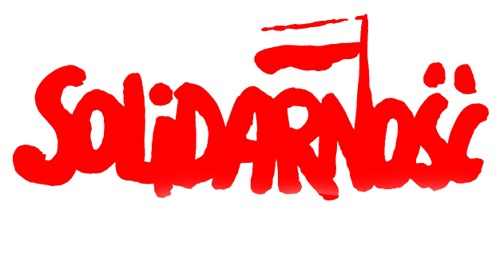
Do I need to explain?

Buława and buzdygan are war maces , often fancifully decorated, symbolizing various positions of power. Both names are of Turkic origin. Although originally the Eastern weapons - Egypt, Iran, Turkey, India - they have become symbols of military commanders of Polish-Lithuanian Commonwealth (PLC) and also later of Dnieper Cossacks.
There were four top commanders in PLC, originally nominated by King for particular war expeditions or defence actions, later nominated or elected for life:
Hetman wielki koronny, Grand Crown Hetman
Hetman polny koronny, Field Crown Hetman
Hetman wielki litewski, Grand Lithuanian Hetman
Hetman polny litewski, Field Lithuanian Hetman
Grand hetmans were the number one military commanders in PLC, second to the kings. The field hetmans were their deputies, but also holding significant power. The word hetman is probably derived from the German "Hauptmann" - the captain, or from the Turkic "otoman"/"ataman".
Buława was an attribute of a hetman. It was made of a handle and a round or pear-shaped head, richly decorated in gold, silver and precious stones. en.wikipedia.org/wiki/Bulawa
Buzdygan was a flanged mace, usually with 6 or 8 flanges, made of brass or steel, sometimes covered with silver or gold material, sometimes decorated with precious stones. It represented authority of Polish colonels, lieutenants and standard-bears. pl.wikipedia.org/wiki/Buzdygan
en.wikipedia.org/wiki/Mace_(club)#Eastern_Europe
There were four top commanders in PLC, originally nominated by King for particular war expeditions or defence actions, later nominated or elected for life:
Hetman wielki koronny, Grand Crown Hetman
Hetman polny koronny, Field Crown Hetman
Hetman wielki litewski, Grand Lithuanian Hetman
Hetman polny litewski, Field Lithuanian Hetman
Grand hetmans were the number one military commanders in PLC, second to the kings. The field hetmans were their deputies, but also holding significant power. The word hetman is probably derived from the German "Hauptmann" - the captain, or from the Turkic "otoman"/"ataman".
Buława was an attribute of a hetman. It was made of a handle and a round or pear-shaped head, richly decorated in gold, silver and precious stones. en.wikipedia.org/wiki/Bulawa
Buzdygan was a flanged mace, usually with 6 or 8 flanges, made of brass or steel, sometimes covered with silver or gold material, sometimes decorated with precious stones. It represented authority of Polish colonels, lieutenants and standard-bears. pl.wikipedia.org/wiki/Buzdygan
en.wikipedia.org/wiki/Mace_(club)#Eastern_Europe

Typical bu�awa of Polish hetmans, 16th century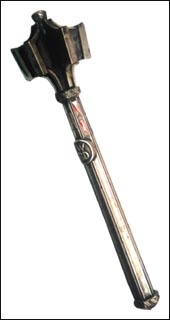
An example of buzdygan
Everybody! Please discuss other symbols, too. Surely Poland has other significant symbols, too. And it is obvious there are so many points and topics in a nation's history that need scientific and technical discussions so as to remove doubts although some doubts and unclear points will always be there. And this is an inherent feature of all histories.
Everybody! Please don't forget about other aspects of Polish life. Why should one speak about military things much? . . . About food, about relationships, cultural life, . . . about religious symbols, . . . dailylife, yes, especially dailylife . . .
Thanks
Everybody! Please don't forget about other aspects of Polish life. Why should one speak about military things much? . . . About food, about relationships, cultural life, . . . about religious symbols, . . . dailylife, yes, especially dailylife . . .
Thanks
The next person who goes off-topic, is out.
Why should one speak about military things much?
Oh, you are spoiled myjustyna - we have already provided you with many other symbols, not necessarily military. And yes, military things were indeed very important part of Polish society - just read the history.
Nevertheless ....
£yżka za cholewą - A spoon inside a boot-top
A very interesting phenomena were old Polish culinary customs. Polish nobility had the habit of carrying a cutlery on their person: a knife in the belt and a spoon inside the boot-top. Each of these items was peculiar. Humorous sentences were engraved on shafts of Polish spoons, and on the other side - coats of arms of the owner. Forks appeared in Poland sooner than in France and were in widespread use already in the seventeenth century.
We know that an Arian, Wacław Potocki, bought in Krakow a knife and a fork, bound in ivory, and for his wife - in the coral. Henry Valois, residing in Wawel Castle for one year (of which he mostly slept and feasted), marvelled at the Polish culinary customs and took with him to France a habit of using a table fork - that's why Valois is considered an inventor of the cutlery.
translated from :
apetycik.pl/teksty.php?tekst=373&kat=28
The beautifully illustrated book "£YŻKA ZA CHOLEWĄ A WIDELEC NA STOLE", 1977, by Maja Berezowska, Stefania i Tadeusz Przypkowscy and Magdalena Samozwaniec humorously describes many Old Polish culinary customs.
I do not know of any English translation of that book.
A spoon inside a boot-top
Do you have a photo of the spoon in a boot-top?
And why did they put the spoon inside a boot-top? . . . Then they took it out whenever they needed to eat something? Perhaps washed it before using it.
Do you have a photo of the spoon in a boot-top?
If the spoon was inside the boot-top one could not spy it - even if they had cameras at those times. So I have no such photo.
And why did they put the spoon inside a boot-top?
A convenient place to store such a precious object without loosing it? Spoons had no hooks to hang at one's belt.
Then they took it out whenever they needed to eat something? Perhaps washed it before using it.
Perhaps they washed it before or perhaps after. A level of the hygiene in Middle Ages was much higher than it is popularly thought of. People washed their hands quite often and they took a bath from time to time.
Poles loved hunting and they did it often. They cooked their meals outdoors (see the origins of the famous Polish hunter's stew, the bigos) - during hunting or on the military march. Having one's own utensils was handy. A modern soldier, when not at base, does exactly the same.
Originally, soups and meats were eaten from simple plates made from the bottom crusts of day-old, stale, bread. It was called a trencher. The trencher would soak up the juices of whatever meat was served on it and could be consumed as part of the meal. It was a very common feature of dinner in a medieval castle.
In the later Middle Ages wooden trenchers evolved. At first they were simple flat boards, but later they contained depressions to hold food, and sometimes separate indentations for salt or a knife.
But trenchers are not specifically Polish. I just wanted you to have a broader picture. en.wikipedia.org/wiki/Trencher_(tableware)
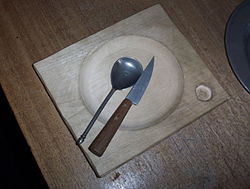
Trencher table setting
A convenient place to store such a precious object without loosing it? Spoons had no hooks to hang at one's belt.
Its very handy place to keep it. The same place was used by members of Russian army during WW2,Ive personnaly spent 5 days at a time with one shoved down my sapogi and never lost one yet :)
Everybody! Please don't forget about other aspects of Polish life.
Some of the best sources are movies. One example is "Rejs"
en.wikipedia.org/wiki/The_Cruise_(film)
The entire movie is available online (in parts) and it's in Polish. I'm unaware of English subtitles.
One of the items used in Poland that I never saw elsewhere were trojaki or dwojaki (triplets or twins/doublets?), sometimes known as menażka. It was use to transport meal mostly by those who worked in larger organozations (such as bog factories" where they had canteens/diners. Dinner would be very inexpensive. There uninsulated so in Winter the dinner had to be reheated.
There was also a version with 4 compartments. The bottom one was usually used for soups, the other ones for the more solid types of food (meat, potatoes, veggies etc):
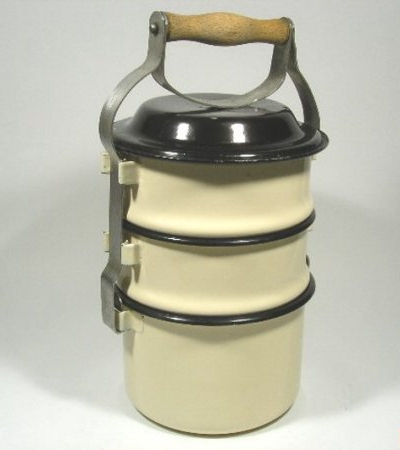
trojaki.jpg
Des Essientes 7 | 1288
15 Jun 2011 / #56
A very interesting phenomena were old Polish culinary customs. Polish nobility had the habit of carrying a cutlery on their person: a knife in the belt and a spoon inside the boot-top.
What about "belt spoons". There is a famous photo of a cigarette smoking Lech Wałesa taken during the Solidarity struggle striding forward and waving and there is a bent spoon attached to his belt that looks like it has something engraved upon it as well? Is this also a traditional Polish ornament and if so what does it symbolize? Also on the subject of bent and engraved metal objects, when I was a boy my father's father gave me an iron horseshoe, with my name engraved upon it, and told me to affix it above the door to my room for good luck. Is this also a Polish tradition, or if not a tradition in all of Poland is it at least a regional one? His parents came from the mountains South of Cracow.
Symbols and signs? Like the Eagle? What is that red sign with white markings outside official offices, is that the eagle too?
delphiandomine 86 | 17813
15 Jun 2011 / #58
One of the items used in Poland that I never saw elsewhere were trojaki or dwojaki
That's really, really odd - look at this -
/tiffin-1.jpg
Hugely popular in India - they're called "tiffin". I'm amazed that Poles had the same idea, too.
y father's father gave me an iron horseshoe
The horseshoe is generally considered a good luck and I've seen it affixed to the main entrance of the house. I have not seen it signed though - so that's the interesting twist. But I do not think that this custom is specifically Polish.
As to Wałęsa and a bent spoon - I have no clue what you are talking about. Perhaps Antek will help. Unless you are talking about "niezbędnik", folded utensils, camping essentials, a toolkit.
Niezbędnik - a combination of a spoon, knife, fork or spoon and fork, designed so that the utensils fold up together or are attached to each other permanently. The kit may also include a can and bottle opener. Used mostly by soldiers, scouts, tourists and lovers of survival.
In the army camp - one of my friends came up with a better name for it - "narządy żrące".
Untranslatable - corrosive organs?
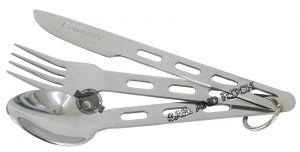
Camp utensils
Des Essientes 7 | 1288
15 Jun 2011 / #60
No it is not a camping utensil but an ornamental spoon attached to his belt I will search the internet for the photo and then provide a link, if I can find it.
 PolishForums LIVE / Archives [3]
PolishForums LIVE / Archives [3]